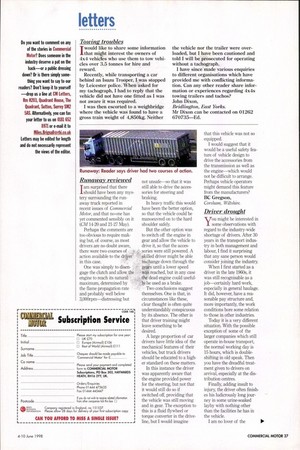Runaway reviewed Jam surprised that there should have been any
Page 29

If you've noticed an error in this article please click here to report it so we can fix it.
mystery surrounding the runaway truck reported in recent issues of Commercial Motor, and that no-one has yet commented sensibly on it (CM 14-20 and 21-27 May).
Perhaps the comments are too obvious to require making but, of course, as most drivers are no doubt aware, there were two courses of action available to the driver in this case.
One was simply to disengage the clutch and allow the engine to reach its natural maximum, determined by the flame propagation rate and probably well below 3,000rpm—distressing but not unsafe—so that it was still able to drive the accessories for steering and braking.
In heavy traffic this would have been the better option, so that the vehicle could be manoeuvred on to the hard shoulder safely.
But the other option was to switch off the engine in gear and allow the vehicle to drive it, so that the accessories were still powered. A skilled driver might be able to change down through the gears until a lower speed was reached, but in any case the dead engine could usefully be used as a brake.
Two conclusions suggest themselves. One is that, in circumstances like these, clear thought is often quite understandably conspicuous by its absence. The other is that driver training might leave something to be desired.
A large proportion of car drivers have little idea of the mechanical features of their vehicles, but truck drivers should be educated to a higher standard on these matters.
In this instance the driver was apparently aware that the engine provided power for the steering, but not that it would still do so if switched off, providing that the vehicle was still moving and in gear. The exception to this is a fluid flywheel or torque converter in the driveline, but I would imagine that this vehicle was not so equipped.
I would suggest that it would be a useful safety feature of vehicle design to drive the accessories from the transmission as well as the engine—which would not be difficult to arrange. Perhaps vehicle operators might demand this feature from the manufacturers? BC Gregson, Corsham, Wiltshire.




















































































































